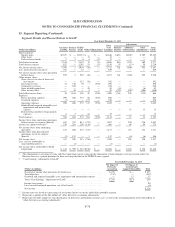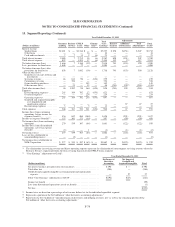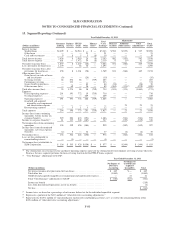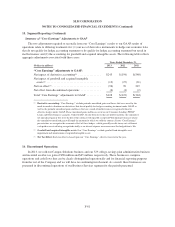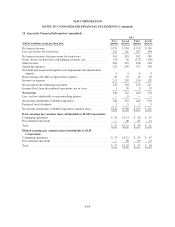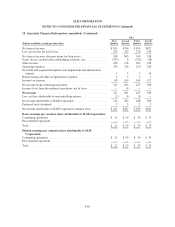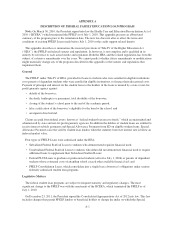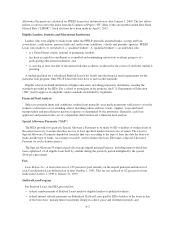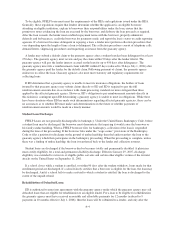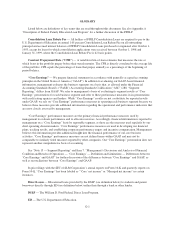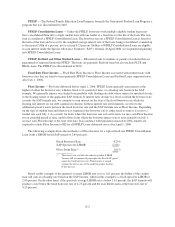Sallie Mae 2013 Annual Report Download - page 226
Download and view the complete annual report
Please find page 226 of the 2013 Sallie Mae annual report below. You can navigate through the pages in the report by either clicking on the pages listed below, or by using the keyword search tool below to find specific information within the annual report.• Special Allowance Payments representing an additional subsidy paid by ED to the holders of eligible
Stafford Loans.
We refer to all three types of assistance as “federal assistance.”
The HEA also permits, and in some cases requires, “forbearance” periods from loan collection in some
circumstances. Interest that accrues during forbearance is never subsidized. Interest that accrues during
deferment periods may be subsidized.
PLUS and Supplemental Loans to Students (“SLS”) Loan Programs
The HEA authorizes PLUS Loans to be made to graduate or professional students (effective July 1, 2006) and
parents of eligible dependent students and previously authorized SLS Loans to be made to the categories of
students subsequently served by the Unsubsidized Stafford Loan program. Borrowers who have no adverse credit
history or who are able to secure an endorser without an adverse credit history are eligible for PLUS Loans, as
well as some borrowers with extenuating circumstances. The federal assistance applicable to PLUS and SLS
Loans are similar to those of Stafford Loans. However, interest subsidy payments are not available under the
PLUS and SLS programs and, in some instances, Special Allowance Payments are more restricted.
The annual and aggregate amounts of PLUS Loans were limited only to the difference between the cost of the
student’s education and other financial aid received, including scholarship, grants and other student loans.
Consolidation Loan Program
The enactment of HCERA ended new originations under the FFELP consolidation program, effective July 1,
2010. Previously, the HEA authorized a program under which borrowers may consolidate one or more of their
student loans into a single FFELP Consolidation Loan that is insured and reinsured on a basis similar to Stafford
and PLUS Loans. FFELP Consolidation Loans were made in an amount sufficient to pay outstanding principal,
unpaid interest, late charges and collection costs on all federally reinsured student loans incurred under the
FFELP that the borrower selects for consolidation, as well as loans made under various other federal student loan
programs and loans made by different lenders. In general, a borrower’s eligibility to consolidate their federal
student loans ends upon receipt of a Consolidation Loan. With the end of new FFELP originations, borrowers
with multiple loans, including FFELP loans, may only consolidate their loans in the DSLP.
Guaranty Agencies under the FFELP
Under the FFELP, guaranty agencies insured FFELP loans made by eligible lending institutions, paying claims
from “federal student loan reserve funds.” These loans are insured as to 100 percent of principal and accrued
interest against death or discharge. FFELP loans are also insured against default, with the percent insured
dependent on the date of the loans disbursement. For loans that were made before October 1, 1993, lenders are
insured for 100 percent of the principal and unpaid accrued interest. From October 1, 1993 to June 30, 2006,
lenders are insured for 98 percent of principal and all unpaid accrued interest. Insurance for loans made on or
after July 1, 2006 was reduced from 98 percent to 97 percent.
ED guarantees to the guaranty agencies reimbursement of amounts paid to lenders on FFELP Loans. Under the
HEA, the guaranty agencies by way of guaranty agreements entered into with ED are, subject to conditions,
deemed to have a contractual right against the United States during the life of the loan to receive reimbursement
for these amounts.
After ED reimburses a guaranty agency for a default claim, the guaranty agency attempts to collect the loan
from the borrower. However, ED requires that the defaulted loans be assigned to it when the guaranty agency is
not successful. A guaranty agency also refers defaulted loans to ED to “offset” any federal income tax refunds or
other federal reimbursement which may be due the borrowers. Some states have similar offset programs.
A-3


